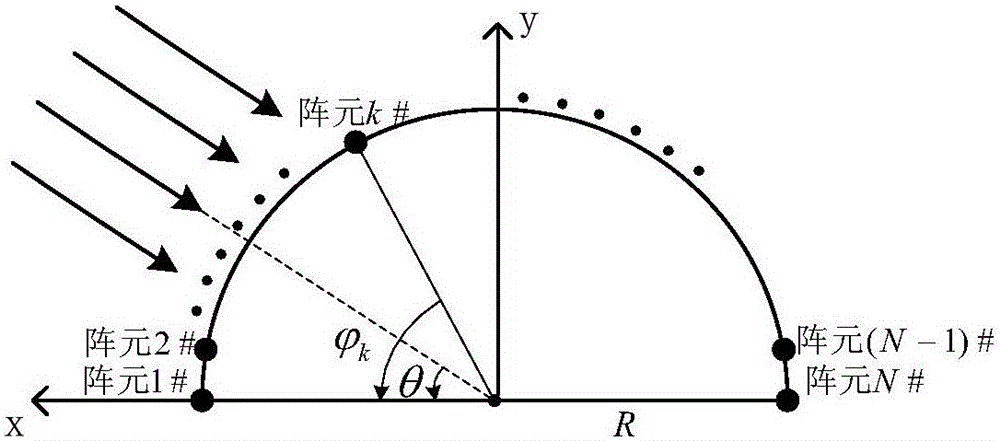Multi-beam imaging sonar sidelobe suppression method and array sparsity method
A sidelobe suppression and multi-beam technology, applied in the field of signal processing in sonar technology, can solve problems such as sidelobe increase, achieve the effects of reducing running time, realizing array sparseness, and good engineering practicability
- Summary
- Abstract
- Description
- Claims
- Application Information
AI Technical Summary
Problems solved by technology
Method used
Image
Examples
specific Embodiment 1
[0051] The sidelobe suppression method of the multi-beam imaging sonar array realizes the sidelobe suppression of the semi-circular array through the given hybrid algorithm based on wind driven optimization (WDO) and convex optimization. In the given hybrid algorithm, the WDO algorithm is used as a global optimization The algorithm searches for the common optimal array element position applicable to all beam directions, and the convex optimization is used as a local optimization algorithm to optimize the weighting coefficients of each beam direction. By using WDO and convex optimization to perform global optimization and local optimization respectively, the proposed hybrid algorithm greatly reduces the possibility of falling into local optimum during the optimization process. The hybrid algorithm includes two stages: in the first stage, the WDO algorithm is used to search for the common optimal array element position applicable to all beam directions; in the second stage, when ...
specific Embodiment 2
[0071] The array sparse method of multi-beam imaging sonar comprises the following steps:
[0072] Step 1. Establish the array sparse model of the multi-beam imaging sonar array under the given main and side lobe performance requirements;
[0073] Sparseness is achieved by extracting part of the array elements from the regular grid on the array, and the binary number '1''0' is used to indicate the presence or absence of array elements in the array. In order to meet the requirement of keeping the width of the main lobe unchanged, the array The two array elements at both ends are reserved (x 1 =x N =1), then the sparse problem is transformed into a mathematical optimization problem under the multi-constraint condition given by (2):
[0074] min | | X 1 | | ...
specific Embodiment 3
[0087] In order to facilitate the understanding of the technical solution, the detailed description will be given below by taking the sparse array based on the multi-beam uniform semicircular array as an example.
[0088] The semicircular array in this embodiment is as figure 1 As shown, it consists of N uniformly distributed array elements 1#, 2#,...,N#, and the distance between the line connecting the array element k# and the center of the array and the x-axis where the reference array element 1# is located The included angle is Where k=1,2,...,N, θ is the angle of arrival of the signal. Assuming that the uniform semicircular array has a total of 180 array elements, 538 narrow beams are to be generated between 45°-135° in order to scan the direction range, and the sidelobe constraint value of the beam PSLL d Set to -25dB. The array radius R is 0.12m, and the signal wavelength λ is 0.0033m.
[0089] In the WDO algorithm, a population is set to contain 30 particles, and t...
PUM
 Login to View More
Login to View More Abstract
Description
Claims
Application Information
 Login to View More
Login to View More - R&D
- Intellectual Property
- Life Sciences
- Materials
- Tech Scout
- Unparalleled Data Quality
- Higher Quality Content
- 60% Fewer Hallucinations
Browse by: Latest US Patents, China's latest patents, Technical Efficacy Thesaurus, Application Domain, Technology Topic, Popular Technical Reports.
© 2025 PatSnap. All rights reserved.Legal|Privacy policy|Modern Slavery Act Transparency Statement|Sitemap|About US| Contact US: help@patsnap.com



